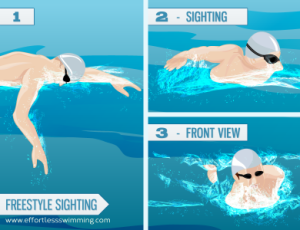If you swim in open water whether you’re a triathlete, an open water swimmer or you just enjoy swimming out in the sea or in the lake then, you’ll need to be sighting because it’s very easy to go off track and off course if you’re not sighting.
There are two main ways to sight. This is one of the ways and it’s probably the easiest way for most swimmers. Now, that way is to sight as you’re extending forward with your lead arm and then to take a breath as your arm comes over in the recovery. So, let’s take a look at the video here. This is of me swimming, I’m just doing a little bit of a practice sight every couple of strokes. So if can see when I extend forward, with my right arm, I’m sighting. And then, when I come over in the recovery with my left arm, I take a breath. So it’s all in one action.
 The other way to do it is to swim with your head up for a couple of strokes but it can be slower for most swimmers. So, this is a really good way just to practice your sighting. You can practice this is in the pool. You can practice by looking up at the end of the lane, if you’ve got a block at the end of the lane, then you can practice sighting that block when you do this.
The other way to do it is to swim with your head up for a couple of strokes but it can be slower for most swimmers. So, this is a really good way just to practice your sighting. You can practice this is in the pool. You can practice by looking up at the end of the lane, if you’ve got a block at the end of the lane, then you can practice sighting that block when you do this.
So in your next training session, this might be the best way for you to sight. Give it a try. See if it works for you. And if you’ve got any other recommendations for sighting that you like to use, I’d love to hear from you on the comments below.
We cover sighting and others ways to sharpen your open water skills more in our Open Water Mastery program.



When I swim along the coast (not straight out to sea) or in a river I try to site two objects in the distance, preferably one behind the other. ie: something near beach and something further back like a large tree, building, etc. That way I can keep them in line when I sight and always swim in a dead straight line.
Cheers
David
Presently swimming of the coast of the Little Cayman in the Caribbean . What helps me in staying the course is to notice the current direction and the weeds flowing in the same direction . Of course this morning I will be swimming where there is no bottom ,& will be using mask/snorkel . Is rather cumbersome to have to lift head & get back on course . To bad we don’t have some directional devise we would where on wrist & GPS our way around some waypoints we put in. Do enjoy/appreciate you web site , the commentaries. Back in States in a couple of weeks.
Cheers
Ed Guillotte
I do what you do but in the opposite direction. I turn my head to take a breath first then instead of rotating my head back into the water I turn forward to sight. I will have to try your way on my next ows and see which works best for me. Thanks
Hi Brenton, I’m with Laura above, I also turn to breathe then roll my head forward during recovery to sight. I tend to sight out of my left eye only though, to keep my head as low as possible.
PS. Using some of your drills to teach my 5yr old daughter to begin to swim freestyle, one arm extended in front with leg kick and head down (to side to breathe) is working a treat. Do you have any other specific drills which may be effective for kids? Maybe a subject for a future update?
Thanks for all the brilliant advice.
Hi Rich, that’s also a good way to sight. It comes down to personal preference.
There’s a lot of drills I’d recommend for young swimmers in the Mastering Freestyle program. THe other main drills I believe are important for young swimmers are scull, long dog paddle, fist freestyle and fingertip drag